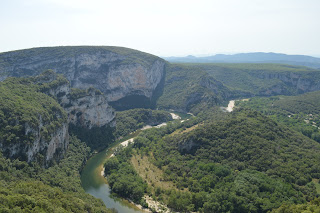Today it was going to be 40-43 degrees when we
visited the Pont du Gard which was very impressive. Its museum was very modern
and effective.
The museum seemed to have a special 3D presentation.
This olive tree is 1000 years old.
The Duke's palace.
Cathedral of Saint-Theodorit.
A natty little street cleaner operating in one of the charming little streets.
After lunch we walked back into the old walled town of Avignon and
visited the Petit Palais Museum.
The Popes Palace.
The Petit Palace Museum.
Their collection concentrates on 12-15th
Century Italian religious art and is very good – the air-conditioning was
excellent, given it was such a hot day with Europe still experiencing a significant heatwave.
Tonight we had an experience at the prestigious
Popes’ Palace of Avignon. After the doors closed to the general public, we had an
exclusive gala dinner and classical concert inside – the food was very good but
it was still quite hot inside. We sat with the tour directors. I took the opportunity to ask them what
would happen in an emergency if the coffee machine on our boat broke down. Apparently there
is only one coffee machine on-board, but three defibrillators. I really think
that Scenic has misplaced priorities.
They organised transport for us to and from the dinner with
mini trains which was a great idea, considering the demographics of the
participants and the heat. It was an interesting ride over the cobblestones.



















































